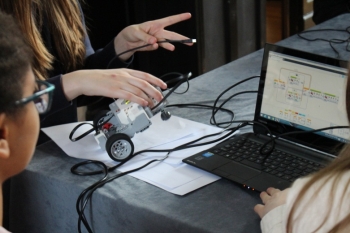Women, Count! Inspiring women in maths, engineering and science
Female students from schools across the country came to Cambridge this week to discover where an interest in science, engineering and mathematics can take them. They met with leading academics and scientists, and had the chance to control robots by writing code.
Over 60 female GCSE students from schools across the country came to Cambridge on a recent visit to learn where an interest in science, engineering and maths could take them.
“Women, Count!” was organised by St John’s College, part of the University of Cambridge, and aims to inspire the next generation of female mathematicians and scientists by giving girls a chance to meet with leading academics in STEM (Science, Technology, Engineering and Mathematics).
Leading female researchers gave talks to the group about their careers in STEM fields, and how science affects society. Third year Engineering student at Cambridge, Esther Sidebotham, discussed how revolutions in civil and medical engineering can potentially save even more lives than doctors.
Attendees also took part in exciting hands-on activities including writing computer code to make music with Cambridge-based computing company Raspberry Pi and designing and building robots from Lego with “Robogals”, a student-run organisation that aims to increase female participation in STEM by using programmable robots to teach the principles of engineering in a fun and creative manner.
 Carrie Anne Philbin, of the Raspberry Pi Foundation, which promotes computer science in schools, said: “Computing is something you really have to try for yourself to fully appreciate. You need the chance to make something, break it and then fix it again. It’s great to be able to do these hands-on coding sessions with young people. It gives them a practical learning experience they’re bound to remember”.
Carrie Anne Philbin, of the Raspberry Pi Foundation, which promotes computer science in schools, said: “Computing is something you really have to try for yourself to fully appreciate. You need the chance to make something, break it and then fix it again. It’s great to be able to do these hands-on coding sessions with young people. It gives them a practical learning experience they’re bound to remember”.
The day ended with a panel discussion about how to best increase diversity in STEM, featuring University of Cambridge academics and women in business, engineering and economics. Rather than simply increasing funding, the speakers suggested that what is needed is a wider initiative to train schools and teachers to recognise, and combat, the unconscious societal bias that encourages more boys than girls to take STEM subjects.
Josena Ann Mathews and Emma Silverwood, both in Year 10 at All Saints School, Sheffield, attended the day with their class. Emma said that she wanted “to learn about what opportunities studying maths and physics could lead to”, and that the day was “really inspiring”.
Josena commented that her favourite part of the day was “problem-solving and doing practical activities like programming and robotics. Even though my robot developed a fault, I enjoyed the challenge of writing a new programme from scratch to fix it. The activities we did really helped show the practical use of maths in real life”.
Megan Goldman-Roberts, Access Officer at St John’s, who organised the “Women, Count!” event, said:
“There is a clear gender disparity in STEM subjects at university. The reasons for this are complicated, but the fact is that fewer girls are taking maths and science at A-level. This event is designed to inspire young women and let them know about the range of opportunities that taking maths and other STEM subjects at A-level can open up to them, both at university and beyond”.